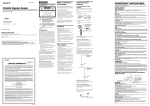Download User Guide
Transcript
User Guide © 2014 Hewlett-Packard Development Company, L.P. Microsoft and Windows are U.S. registered trademarks of the Microsoft group of companies. The information contained herein is subject to change without notice. The only warranties for HP products and services are set forth in the express warranty statements accompanying such products and services. Nothing herein should be construed as constituting an additional warranty. HP shall not be liable for technical or editorial errors or omissions contained herein. First Edition: December 2014 Document Part Number: 800833-001 About This Guide This guide provides information on monitor features, setting up the monitor, and technical specifications. WARNING! Text set off in this manner indicates that failure to follow directions could result in bodily harm or loss of life. CAUTION: Text set off in this manner indicates that failure to follow directions could result in damage to equipment or loss of information. NOTE: Text set off in this manner provides important supplemental information. TIP: Text set off in this manner provides helpful hints. iii iv About This Guide Table of contents 1 Product features ........................................................................................................................................... 1 HP Z display ........................................................................................................................................................... 1 2 Safety and maintenance guidelines ................................................................................................................ 2 Important safety information ............................................................................................................................... 2 Maintenance guidelines ......................................................................................................................................... 3 Cleaning the monitor ........................................................................................................................... 3 Shipping the monitor ........................................................................................................................... 3 3 Setting up the monitor ................................................................................................................................... 4 Use caution when setting up the monitor ............................................................................................................. 4 Installing the stand ................................................................................................................................................ 5 Identifying rear and side components .................................................................................................................. 6 Connecting the cables ............................................................................................................................................ 7 Identifying front panel controls ............................................................................................................................ 9 Adjusting the monitor .......................................................................................................................................... 10 Turning on the monitor ....................................................................................................................................... 11 Connecting USB devices ...................................................................................................................................... 12 Removing the monitor stand .............................................................................................................................. 13 Mounting the Monitor .......................................................................................................................................... 13 Locating the serial number and product number ............................................................................................... 15 Installing a cable lock .......................................................................................................................................... 15 4 Operating the monitor ................................................................................................................................. 16 Software and utilities .......................................................................................................................................... 16 The Information file .......................................................................................................................... 16 The Image Color Matching file .......................................................................................................... 16 Installing the .INF and .ICM files .......................................................................................................................... 16 Installing from the disc ..................................................................................................................... 16 Downloading from the Web .............................................................................................................. 17 Using the On-Screen Display (OSD) menu ........................................................................................................... 18 Reconfiguring the Function buttons ................................................................................................................... 19 Factory calibration ............................................................................................................................................... 20 Appendix A Technical specifications ................................................................................................................ 21 Recognizing preset display resolutions .............................................................................................................. 22 v Entering user modes ......................................................................................................................... 22 Appendix B Support and troubleshooting ......................................................................................................... 23 Solving common problems .................................................................................................................................. 23 Button lockouts ................................................................................................................................................... 23 Product support ................................................................................................................................................... 24 Preparing to call technical support ..................................................................................................................... 24 Appendix C LCD monitor quality and pixel policy ............................................................................................... 25 Appendix D Accessibility ................................................................................................................................. 26 Supported assistive technologies ....................................................................................................................... 26 Contacting support .............................................................................................................................................. 26 vi 1 Product features HP Z display The monitor features include: ● 68.6 cm (27-inch) diagonal viewable area display with 5120 x 2880 QQHD resolution, plus full-screen support for lower resolutions ● Non-glare panel with an LED backlight ● Wide viewing angle to allow viewing from a sitting or standing position, or moving from side-to-side ● Tilt capability ● Swivel and height adjustment capabilities ● Removable stand for flexible monitor panel mounting solutions ● HP Quick Release 2 device to quickly install the monitor panel to the stand with a simple click, and then remove it with the convenient sliding tab release ● Two DisplayPort video inputs ● USB 3.0 hub with one upstream port (connects to the computer) and four downstream ports (connect to USB devices) ● USB cable provided to connect the monitor's USB hub to the USB connector on the computer ● Five front bezel menu buttons, four that are reconfigurable to quickly allow selection of the most commonly used operations ● Supports an optional HP speaker bar ● Plug and play capability if supported by your operating system ● Security slot provision on the rear of the monitor for an optional cable lock ● Cable management feature for placement of cables and cords ● On-Screen Display (OSD) adjustments in several languages for easy setup and screen optimization ● HDCP (High-Bandwidth Digital Content Protection) copy protection on all digital inputs ● Software and documentation disc that includes monitor drivers and product documentation ● Energy saver feature to meet requirements for reduced power consumption NOTE: For safety and regulatory information, refer to the Product Notices provided on your media disc, if one is included, or in your documentation kit. To locate updates to the user guide for your product, go to http://www.hp.com/support, and select your country. Select Drivers & Downloads, and then follow the onscreen instructions. HP Z display 1 2 Safety and maintenance guidelines Important safety information A power cord is included with the monitor. If another cord is used, use only a power source and connection appropriate for this monitor. For information on the correct power cord set to use with the monitor, refer to the Product Notices provided on your media disc, if one is included, or in your documentation kit. WARNING! To reduce the risk of electric shock or damage to the equipment: • Plug the power cord into an AC outlet that is easily accessible at all times. • Disconnect power from the monitor by unplugging the power cord from the AC outlet. • If provided with a 3-pin attachment plug on the power cord, plug the cord into a grounded (earthed) 3-pin outlet. Do not disable the power cord grounding pin, for example, by attaching a 2-pin adapter. The grounding pin is an important safety feature. For your safety, do not place anything on power cords or cables. Arrange them so that no one may accidentally step on or trip over them. Do not pull on a cord or cable. When unplugging from the electrical outlet, grasp the cord by the plug. To reduce the risk of serious injury, read the Safety and Comfort Guide. It describes proper workstation, setup, posture, and health and work habits for computer users, and provides important electrical and mechanical safety information. This guide is located on the Web at http://www.hp.com/ergo. CAUTION: For the protection of the monitor, as well as the computer, connect all power cords for the computer and its peripheral devices (such as a monitor, printer, scanner) to some form of surge protection device such as a power strip or Uninterruptible Power Supply (UPS). Not all power strips provide surge protection; the power strips must be specifically labeled as having this ability. Use a power strip whose manufacturer offers a Damage Replacement Policy so you can replace the equipment, if surge protection fails. Use the appropriate and correctly sized furniture designed to properly support your HP LCD monitor. WARNING! LCD monitors that are inappropriately situated on dressers, bookcases, shelves, desks, speakers, chests, or carts may fall over and cause personal injury. Care should be taken to route all cords and cables connected to the LCD monitor so that they cannot be pulled, grabbed, or tripped over. NOTE: This product is suitable for entertainment purposes. Consider placing the display in a controlled luminous environment to avoid interference from surrounding light and bright surfaces that may cause disturbing reflections from the screen. 2 Chapter 2 Safety and maintenance guidelines Maintenance guidelines To enhance the performance and extend the life of the monitor: ● Do not open the monitor cabinet or attempt to service this product yourself. Adjust only those controls that are covered in the operating instructions. If the monitor is not operating properly or has been dropped or damaged, contact an authorized HP dealer, reseller, or service provider. ● Use only a power source and connection appropriate for this monitor, as indicated on the label/back plate of the monitor. ● Be sure the total ampere rating of the products connected to the outlet does not exceed the current rating of the electrical outlet, and the total ampere rating of the products connected to the cord does not exceed the rating of the cord. Look on the power label to determine the ampere rating (AMPS or A) for each device. ● Install the monitor near an outlet that you can easily reach. Disconnect the monitor by grasping the plug firmly and pulling it from the outlet. Never disconnect the monitor by pulling the cord. ● Turn the monitor off when not in use. You can substantially increase the life expectancy of the monitor by using a screen saver program and turning off the monitor when not in use. NOTE: Monitors with a “burned-in image” are not covered under the HP warranty. ● Slots and openings in the cabinet are provided for ventilation. These openings must not be blocked or covered. Never push objects of any kind into cabinet slots or other openings. ● Do not drop the monitor or place it on an unstable surface. ● Do not allow anything to rest on the power cord. Do not walk on the cord. ● Keep the monitor in a well-ventilated area, away from excessive light, heat or moisture. ● When removing the monitor stand, you must lay the monitor face down on a soft area to prevent it from getting scratched, defaced, or broken. Cleaning the monitor 1. Turn off the monitor and unplug the power cord from the back of the unit. 2. Dust the monitor by wiping the screen and the cabinet with a soft, clean antistatic cloth. 3. For more difficult cleaning situations, use a 50/50 mix of water and Isopropyl alcohol. CAUTION: Spray the cleaner onto a cloth and use the damp cloth to gently wipe the screen surface. Never spray the cleaner directly on the screen surface. It may run behind the bezel and damage the electronics. CAUTION: Do not use cleaners that contain any petroleum based materials such as benzene, thinner, or any volatile substance to clean the monitor screen or cabinet. These chemicals may damage the monitor. Shipping the monitor Keep the original packing box in a storage area. You may need it later if you move or ship the monitor. Maintenance guidelines 3 3 Setting up the monitor To set up the monitor, ensure that the power is turned off to the monitor, computer system, and other attached devices, then follow the instructions below. NOTE: Be sure the master power switch, located on the rear panel of the monitor, is in the off position. The master power switch turns off all power to the monitor. Use caution when setting up the monitor To prevent damage to the monitor, do not touch the surface of the LCD panel. Pressure on the panel may cause non-uniformity of color or disorientation of the liquid crystals. If this occurs the screen will not recover to its normal condition. If installing a stand, lay the monitor face down on a flat surface covered with a protective sheet foam or nonabrasive cloth. This prevents the screen from getting scratched, defaced or broken as well as damage to the front panel buttons. NOTE: Your monitor may look different from the monitor in this illustration. 4 Chapter 3 Setting up the monitor Installing the stand CAUTION: Do not touch the surface of the LCD panel. Pressure on the panel may cause non-uniformity of color or disorientation of the liquid crystals. If this occurs the screen will not recover to its normal condition. TIP: Consider the placement of the display, because the bezel might cause interfering reflections from surrounding light and bright surfaces. The display uses the HP Quick Release 2 for easy mounting of the monitor. To mount the panel onto the stand: 1. Lay the monitor panel face down on a flat surface covered by a clean, dry cloth. 2. Slide the top of the stand's mounting plate (1) under the upper lip of the recess in the back of the panel. 3. Lower the bottom of the stand's mounting plate (2) into the recess until it snaps into place. 4. The HP Quick Release 2 latch (3) pops up when the stand is locked in place. Installing the stand 5 Identifying rear and side components Component Function 1 USB 3.0 Downstream with Charging (side panel) Connects optional USB devices to the monitor. 2 USB 3.0 Downstream (side panel) Connects optional USB devices to the monitor. 3 Master Power Switch Turns off all power to the monitor. NOTE: The USB 3.0 Downstream with Charging port provides current to charge a device such as a smart phone or tablet even when the monitor is in Sleep mode. NOTE: Putting the switch in the Off position will yield the lowest power state for the monitor when not in use. 4 Power Connector Connects the AC power cord to the monitor. 5 DisplayPort 1 Connects the first DisplayPort cable from the source device to the monitor. 6 DisplayPort 2 Connects the second DisplayPort cable from the source device to the monitor. 7 USB 3.0 Upstream Connects the USB hub cable from the source device to the monitor. 8 USB 3.0 Downstream Connects optional USB devices to the monitor. NOTE: The monitor requires two DisplayPort connections between the source device and the monitor when displaying at native 5120 x 2880 resolution. 6 Chapter 3 Setting up the monitor Connecting the cables NOTE: The monitor ships with select cables. Not all cables shown in this section are included with the monitor. 1. Place the monitor in a convenient, well-ventilated location near the computer or source device. 2. Before connecting the cables, route the cables through the cable routing hole in the center of the stand. 3. Connect two DisplayPort video cables to the DisplayPort connectors on the rear of the monitor and the other ends of the cables to two DisplayPort connectors on the source device. NOTE: The monitor requires two DisplayPort connections between the source device and the monitor. Connecting the cables 7 4. Connect the USB upstream cable’s Type B connector to the USB upstream port on the rear of the monitor and the cable’s Type A connector to the USB downstream port on the source device. 5. Connect one end of the AC power cord to the power connector on the rear of the monitor, and the other end to an AC outlet. WARNING! To reduce the risk of electric shock or damage to the equipment: Do not disable the power cord grounding plug. The grounding plug is an important safety feature. Plug the power cord into a grounded (earthed) electrical outlet that is easily accessible at all times. Disconnect power from the equipment by unplugging the power cord from the AC outlet. For your safety, do not place anything on power cords or cables. Arrange them so that no one may accidentally step on or trip over them. Do not pull on a cord or cable. When unplugging from the electrical outlet, grasp the cord by the plug. 8 Chapter 3 Setting up the monitor Identifying front panel controls Control 1 Function Menu button Opens and closes the OSD menu. NOTE: To activate the Menu button and the Function buttons, press any of the buttons so that the button labels appear on the screen. 2 Function buttons Use these buttons to navigate through the OSD based on the indicators next to the buttons that are activated while the OSD is open. NOTE: You can reconfigure the Function buttons in the OSD to quickly select the most commonly used operations. See Reconfiguring the Function buttons on page 19 for more information. 3 Power button Turns the monitor on or off. NOTE: Be sure the master power switch on the rear of the monitor is in the ON position to turn on the monitor. NOTE: To view an OSD menu simulator, visit the HP Customer Self Repair Services Media Library at http://www.hp.com/go/sml. Identifying front panel controls 9 Adjusting the monitor 10 1. Tilt the monitor's panel forward or backward to set it to a comfortable eye level. 2. Swivel the monitor to the left or right for the best viewing angle. Chapter 3 Setting up the monitor 3. Adjust the monitor’s height to a comfortable position for your individual workstation. The monitor’s top bezel edge should not exceed a height that is parallel to your eye height. A monitor that is positioned low and reclined may be more comfortable for users with corrective lenses. The monitor should be repositioned as you adjust your working posture throughout the work day. Turning on the monitor 1. Set the master power switch on the rear of the monitor to the On position. 2. Press the power button on the computer to turn it on. 3. Press the power button on the front of the monitor to turn it on. CAUTION: Burn-in image damage may occur on monitors that display the same static image on screen for a prolonged period of time.* To avoid burn-in image damage on the monitor screen, you should always activate a screen saver application or turn off the monitor when it is not in use for a prolonged period of time. Image retention is a condition that may occur on all LCD screens. Monitors with a “burned-in image” are not covered under the HP warranty. * A prolonged period of time is 12 consecutive hours of a static image. Turning on the monitor 11 NOTE: If pressing the power button has no effect, the Power Button Lockout feature may be enabled. To disable this feature, press and hold the monitor power button for 10 seconds. NOTE: You can disable the power LED in the OSD menu. Press the Menu button on the front of the monitor, and then select Power Control > Power LED > Off. When the monitor is powered on, a Monitor Status message is displayed for five seconds. The message shows the current active input signal, the current preset display resolution, and the recommended preset display resolution. The monitor automatically scans the signal inputs for an active input and uses that input for the display. Connecting USB devices USB ports are used to connect devices such as a digital camera, USB keyboard, or USB mouse. There are four downstream USB ports on the monitor (two on the rear and two on the side). NOTE: You must connect the USB upstream cable from the computer to the monitor to enable the USB downstream ports on the monitor. See step 4 in Connecting the cables on page 7. NOTE: The upper port on the side panel is a charging port that provides current to charge a device such as a smart phone or tablet even when the monitor is in Sleep mode. 12 Chapter 3 Setting up the monitor Removing the monitor stand You can remove the monitor panel from the stand to install the panel on a wall, a swing arm, or other mounting fixture. CAUTION: Before beginning to disassemble the monitor, be sure the monitor is turned off and all cables are disconnected. 1. Disconnect and remove all cables from the monitor. 2. Lay the monitor face down on a flat surface covered by a clean, dry cloth. 3. Push up the latch near the bottom center of the monitor to unlock the HP Quick Release 2 (1). 4. Swing the bottom of the stand up until the mounting plate clears the recess in the panel (2). 5. Slide the stand out of the recess (3). Mounting the Monitor The monitor panel can be attached to a wall, swing arm, or other mounting fixture. NOTE: This apparatus is intended to be supported by UL or CSA Listed wall mount bracket. CAUTION: This monitor supports the VESA industry standard 100 mm mounting holes. To attach a thirdparty mounting solution to the monitor, four 4mm diameter, 0.7 pitch, and 10 mm long screws (M4 x 10mm screws) are required. Longer screws must not be used because they may damage the monitor. It is important to verify that the manufacturer’s mounting solution is compliant with the VESA standard and is rated to support the weight of the monitor display panel. For best performance, it is important to use the power and video cables provided with the monitor. 1. Remove the monitor from the stand (see Removing the monitor stand on page 13). Removing the monitor stand 13 14 2. Remove the four screws from the VESA holes located on the rear of the monitor panel. 3. Use the four screws removed from the VESA holes on rear of the monitor panel to attach the mounting device to the monitor. Chapter 3 Setting up the monitor Locating the serial number and product number The Safety label (1) and Rating label (2) are located on the rear of the monitor. The serial number and product number are located on a Rating label. You may need these numbers when contacting HP about the monitor model. Installing a cable lock You can secure the monitor to a fixed object with an optional cable lock available from HP. Locating the serial number and product number 15 4 Operating the monitor Software and utilities The disc that comes with the monitor contains files you can install on the computer: ● an .INF (Information) file ● ICM (Image Color Matching) files (one for each calibrated color space) The Information file The .INF file defines monitor resources used by Microsoft Windows operating systems to ensure monitor compatibility with the computer’s graphics adapter. This monitor is Microsoft Windows Plug and Play compatible and the monitor will work correctly without installing the .INF file. Monitor Plug and Play compatibility requires that the computer’s graphic card is VESA DDC2–compliant and that the monitor connects directly to the graphics card. Plug and Play does not work through separate BNC type connectors or through distribution buffers/boxes. The Image Color Matching file The .ICM files are data files that are used in conjunction with graphics programs to provide consistent color matching from monitor screen to printer, or from scanner to monitor screen. This file is activated from within graphics programs that support this feature. NOTE: The ICM color profile is written in accordance with the International Color Consortium (ICC) Profile Format specification. Installing the .INF and .ICM files After you determine that you need to update, you can install the .INF and .ICM files from the disc or download them. Installing from the disc To install the .INF and .ICM files on the computer from the disc: 1. Insert the disc in the computer optical drive. The disc menu is displayed. 2. View the HP Monitor Software Information file. 3. Select Install Monitor Driver Software. 4. Follow the on-screen instructions. 5. Ensure that the proper resolution and refresh rates appear in the Windows Display control panel. NOTE: You may need to install the digitally signed monitor .INF and .ICM files manually from the disc in the event of an installation error. Refer to the HP Monitor Software Information file on the disc. 16 Chapter 4 Operating the monitor Downloading from the Web If you do not have a computer or source device with an optical drive, you can download the latest version of .INF and .ICM files from the HP monitors support Web site: 1. Go to http://www.hp.com/support and select the appropriate country and language. 2. Select Drivers & Downloads, type your monitor model in the Find my product search field, and click Go. 3. If necessary, select your monitor from the list. 4. Select your operating system, and then click Next. 5. Click Driver - Display/Monitor to open the list of drivers. 6. Click on the driver. 7. Click the System Requirements tab, and then verify that your system meets the program minimum requirements. 8. Click Download and follow the on-screen instructions to download the software. Installing the .INF and .ICM files 17 Using the On-Screen Display (OSD) menu Use the On-Screen Display (OSD) menu to adjust the monitor settings screen image based on your preferences. You can access and make adjustments in the OSD using the buttons on the monitor's front panel. To access the OSD and make adjustments, do the following: 1. If the monitor is not already on, press the power button to turn on the monitor. 2. To access the OSD menu, press one of the five front bezel buttons to activate the buttons, and then press the Menu button to open the OSD. 3. Use the four Function buttons to navigate, select, and adjust the menu choices. The button labels are variable depending on the menu or sub-menu that is active. The following table lists the menu selections in the main menu. 18 Main Menu Description Luminance Adjusts the luminance level of the screen. Color Control Selects and adjusts the screen color. Input Control Adjusts the video input signal. Image Control Adjusts the screen image. Power Control Adjusts the power settings. OSD Control Adjusts the on-screen display (OSD) and Function button controls. Management Enables/disables DDC/CI support and returns all OSD menu settings to the factory default settings. Language Selects the language in which the OSD menu is displayed. The factory default is English. Information Displays important information about the monitor. Exit Exits the OSD menu screen. Chapter 4 Operating the monitor Reconfiguring the Function buttons Pressing one of the five front bezel buttons activates the buttons and displays the icons above the buttons. The factory default button icons and functions are shown below. Button Function 1 Menu Opens the OSD (On-Screen Display) main menu. 2 Text Toggles between text and icons displayed above the buttons. (Function button 1) 3 Information Opens the Information menu. (Function button 2) 4 Color Control Opens the Color Control menu. (Function button 3) 5 Luminance Opens the Luminance adjustment scale. (Function button 4) 6 Power Turns the monitor on or off. You can change the Function buttons from their default values so that when the buttons are activated you can quickly access commonly used menu items. To reconfigure the Function buttons: 1. Press one of the five front bezel buttons to activate the buttons, and then press the Menu button to open the OSD. 2. In the OSD, select OSD Control > Configure Function Buttons and then select one of the available options for the button you want to reconfigure. NOTE: You can only reconfigure the four Function buttons. You can not reconfigure the Menu button or the power button. Reconfiguring the Function buttons 19 Factory calibration The following color spaces are pre-calibrated at the factory: ● sRGB ● AdobeRGB ● BT.709 The following color spaces are also available and are not pre-calibrated at the factory: 20 ● Warm ● Neutral ● Cool ● Custom RGB Chapter 4 Operating the monitor A Technical specifications NOTE: All specifications represent the typical specifications provided by HP's component manufacturers; actual performance may vary either higher or lower. For the latest specifications or additional specifications on this product, go to http://www.hp.com/go/ quickspecs/ and search for your specific display model to find the model-specific QuickSpecs. Display 68.6 wide screen 27 inches wide screen Type LCD Viewable Image Size 68.6 cm diagonal 27-inch diagonal Maximum Weight (Unpacked) 7.42 kg 16.36 lbs Height (highest position) 54.88 cm 21.61 inches Height (lowest position) 41.92 cm 16.50 inches Depth 21.72 cm 8.55 inches Width 63.43 cm 24.97 inches Maximum Graphic Resolution 5120 x 2880 (60 Hz) Optimum Graphic Resolution 5120 x 2880 (60 Hz) Dimensions (include base) Environmental Requirements Temperature Operating Temperature 5 to 35° C 41 to 95° F Storage Temperature -20 to 60° C -4 to 140° F Power Source 100 – 240 VAC 50/60 Hz Input Terminal Two DisplayPort connectors 21 Recognizing preset display resolutions The display resolutions listed below are the most commonly used modes and are set as factory defaults. This monitor automatically recognizes these preset modes and they will appear properly sized and centered on the screen. Preset Resolution Refresh Rate 1 640 × 480 59.940 2 800 × 600 60.317 3 1024 × 768 60.004 4 1280 × 720 59.940 5 1280 × 768 59.995 6 1280 × 800 59.810 7 1280 × 1024 60.020 8 1366 × 768 59.790 9 1440 × 900 59.901 10 1600 × 900 60.000 11 1600 × 1200 60.000 12 1680 × 1050 59.954 13 1920 × 1080 60.000 14 1920 × 1200 59.950 15 1920 × 1200 59.885 16 2560 × 1440 59.900 17 2560 × 1600 59.972 18 3840 × 2160 59.997 19 4096 × 2160 59.983 20 5120 × 2880 60.000 NOTE: Two DisplayPort cables are required between the host computer and the monitor to be able to display the native 5120 × 2880 resolution. Entering user modes The video controller signal may occasionally call for a mode that is not preset if: ● You are not using a standard graphics adapter. ● You are not using a preset mode. If this occurs, you may need to readjust the parameters of the monitor screen by using the on-screen display. Your changes can be made to any or all of these modes and saved in memory. The monitor automatically stores the new setting, and then recognizes the new mode just as it does a preset mode. In addition to the factory preset modes, there are at least 10 user modes that can be entered and stored. 22 Appendix A Technical specifications B Support and troubleshooting Solving common problems The following table lists possible problems, the possible cause of each problem, and the recommended solutions. Problem Possible Cause Solution Screen is blank. Power cord is disconnected. Connect the power cord. Power button is turned off. Press the front panel power button. NOTE: If pressing the power button has no effect, press and hold the power button for 10 seconds to disable the power button lockout feature. Master power switch is turned off. Set the master power switch on the rear of the monitor to the On position. Video cable is improperly connected. Connect the video cable properly. See Connecting the cables on page 7 for more information. System is in sleep mode. Press any key on the keyboard or move the mouse to inactivate the screen blanking utility. Image appears blurred, indistinct, or too dark. Luminance is too low. Open the OSD menu and select Luminance to adjust the luminance scale as needed. Check Video Cable is displayed on screen. Monitor video cable is disconnected. Connect the appropriate video signal cable between the computer and monitor. Be sure that the computer power is off while connecting the video cable. Input Signal Out of Range is displayed on screen. Video resolution and/or refresh rate are set higher than what the monitor supports. Change the settings to a supported setting (see Recognizing preset display resolutions on page 22). The monitor is off but it did not seem to enter into a lowpower sleep mode. The monitor's power saving control is disabled. Open the OSD menu and select Power Control > Auto-Sleep Mode and set auto-sleep to Enable. OSD Lockout is displayed. The monitor's OSD Lockout function is enabled. Press and hold the Menu button on the front panel for 10 seconds to disable the OSD Lockout function. Power Button Lockout is displayed. The monitor's Power Button Lockout function is enabled. Press and hold the power button for 10 seconds to unlock the power button function. Button lockouts Holding down the power button or Menu button for ten seconds will lock out the functionality of that button. You can restore the functionality by holding the button down again for ten seconds. This functionality is only available when the display is powered on, displaying an active signal, and the OSD is not active. Solving common problems 23 Product support For additional information on using your monitor, go to http://www.hp.com/support. Select your country or region, select Troubleshooting, and then enter your model in the search window and click the Go button. NOTE: The monitor user guide, reference material, and drivers are available at http://www.hp.com/ support. If the information provided in the guide does not address your questions, you can contact support. For U.S. support, go to http://www.hp.com/go/contactHP. For worldwide support, go to http://welcome.hp.com/ country/us/en/wwcontact_us.html. Here you can: ● Chat online with an HP technician NOTE: When support chat is not available in a particular language, it is available in English. ● Find support telephone numbers ● Locate an HP service center Preparing to call technical support If you cannot solve a problem using the troubleshooting tips in this section, you may need to call technical support. Have the following information available when you call: 24 ● Monitor model number ● Monitor serial number ● Purchase date on invoice ● Conditions under which the problem occurred ● Error messages received ● Hardware configuration ● Name and version of the hardware and software you are using Appendix B Support and troubleshooting C LCD monitor quality and pixel policy The TFT monitor uses high-precision technology, manufactured according to HP standards, to guarantee trouble-free performance. Nevertheless, the display may have cosmetic imperfections that appear as small bright or dark spots. This is common to all LCD displays used in products supplied by all vendors and is not specific to the HP LCD. These imperfections are caused by one or more defective pixels or sub-pixels. ● A pixel consists of one red, one green, and one blue sub-pixel. ● A defective whole pixel is always turned on (a bright spot on a dark background), or it is always off (a dark spot on a bright background). The first is the more visible of the two. ● A defective sub-pixel (dot defect) is less visible than a defective whole pixel and is small and only visible on a specific background. To locate defective pixels, the monitor should be viewed under normal operating conditions, in normal operating mode at a supported resolution and refresh rate, from a distance of approximately 50 cm (20 in). HP expects that, over time, the industry will continue to improve its ability to produce LCDs with fewer cosmetic imperfections and HP will adjust guidelines as improvements are made. 25 D Accessibility HP designs, produces, and markets products and services that can be used by everyone, including people with disabilities, either on a stand-alone basis or with appropriate assistive devices. Supported assistive technologies HP products support a wide variety of operating system assistive technologies and can be configured to work with additional assistive technologies. Use the Search feature on your device to locate more information about assistive features. NOTE: For additional information about a particular assistive technology product, contact customer support for that product. Contacting support We are constantly refining the accessibility of our products and services and welcome feedback from users. If you have an issue with a product or would like to tell us about accessibility features that have helped you, please contact us at (888) 259-5707, Monday through Friday, 6 a.m. to 9 p.m. Mountain Time. If you are deaf or hard-of-hearing and use TRS/VRS/WebCapTel, contact us if you require technical support or have accessibility questions by calling (877) 656-7058, Monday through Friday, 6 a.m. to 9 p.m. Mountain Time. 26 Appendix D Accessibility













































